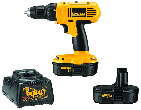Have you ever had a problem with your toilet, called a plumber, only to find out that the problem really wasn't really all that major to begin with. Granted, after finding this out you usually have to pay $100 or more. Diagnosing toilet problems yourself can not only save you some money that you can use in a variety of other ways, by either telling the plumber what the problem is or by being able to fix the problem yourself.
Now that you have a rough idea of where the problem lies, you can begin to either work on the problem or let the plumber know what's going on. With the problem diagnosed, you can easily figure out what you need to do to fix it. Luckily, most of the problems you will be able to fix yourself, or at least you can if you have the right instructions and a bit of self confidence.

Cordless, Compact, and Powerful! DeWalt's 18-volt drill-driver kit packs a big punch in a small package, with a powerful high-performance motor tucked away inside a compact design. A great addition to the tool chest of any professional or DIYer! Check out DeWalt 18-Volt Drill/Driver Kit today!
Have you ever noticed how the toilet is one of the more common reasons to end up calling a plumber? Knowing the right ...
Discover MoreOne of the more common problems that you can find around a toilet is called sweating. In severe cases this can make you ...
Discover MoreCompared with the nearly 7 gallons of water it takes to flush a pre-1993 toilet, low-flow toilets take a mere 1.6 gallons ...
Discover More2013-08-02 19:21:03
Norman
I used to use Clorox brand Chlorine discs in the toilet tank only to discover that the chlorine chemically reacted withthe flapper seal and caused the seal to pucker thus leaving no seal and a need to replace the flapper assembly.
Does anyone know of a treatment that won't react with the rubber/plastic material that the flapper assembly is made from?
2013-08-02 14:33:32
Tom
My toilet water in my master bathroom smells horrible. Cleaning the tank and the bowl have no effect on the odor. Three other bathrooms have no problem with the smell--any idea where it is coming from or a solution??
Copyright © 2025 Sharon Parq Associates, Inc.
Comments